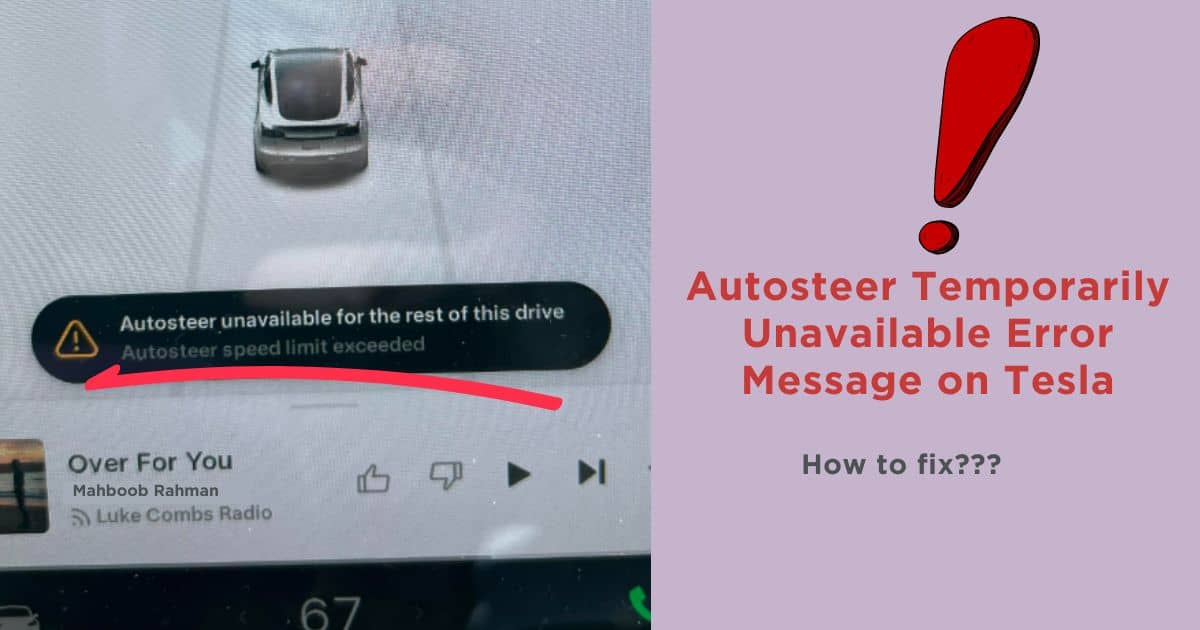Tesla cars have some of the coolest features in the industry. One of these features is Autosteer, where the vehicle steers itself with the help of radar, sensors, and cameras. But this feature only works under certain conditions.
So, why does the ‘Autosteer temporarily unavailable’ error message appear? Autosteer can be temporarily unavailable if there are obstructions to sensors or cameras. Bad weather conditions or lack of proper road markings can also make the feature unavailable. Also, if you cross the speed limit for the feature, it will be unavailable.
Besides, there can be other reasons. You will learn all possible reasons for this error and their solutions to fix the problem effectively. Let’s get started.
Reasons For ‘Autosteer Temporarily Unavailable’ Error Message
Autosteer can be temporarily unavailable for the following reasons. Check the detailed reasons and their fixes.
1. Cameras or Sensors Are Obstructed or Broken
For any autopilot feature, your Tesla requires a bunch of sensors, cameras, and radar. These components are crucial for identifying the surroundings of the vehicle and steering the vehicle on its own.
So, if any of the required components are obstructed or broken, the Autosteer feature will be temporarily unavailable.
Dust or mud can sometimes obstruct the sensors and cameras. Minor accidents can impact the cameras and sensors on the front and rear fenders. In such cases, the Autosteer feature will not work.
Solutions
Follow the solutions below to fix the component issue.
- You should inspect the cameras and sensors visually. Check for signs of damage or obstruction.
- For broken cameras or sensors, you should contact the Tesla service center near your location. They will replace the damaged sensors or cameras.
- Use a water spray bottle to clean any dust or debris on the cameras or sensors. However, it is better not to use any cloth to wipe the cameras or sensors.
To learn more about potential issues affecting Tesla’s Autosteer functionality, visit our article on Automatic Emergency Braking in Tesla, which explores instances where emergency braking may be disabled.
2. Cameras or Sensors Aren’t Calibrated
After every software update or service, the sensors and cameras need to be calibrated properly. If you don’t calibrate the sensors, they will not work properly. As a result, the Autosteer feature will be temporarily unavailable. Fortunately, this has an easy solution.
Solution
You need to reboot the system first. Park your vehicle in a safe place and press the brake pedal. Then, follow the process below.
- Press the “T” on the screen and go to “Controls”.
- Then, choose the “Safety & Security” tab.
- Tap on “Power Off” and press “Yes” to confirm.
- The screen will go dark in a bit. When the screen is dark, release the brake.
- After a few minutes, press the brake again. The screen will now light up.
- Now, you need to drive normally. It is better if you drive on properly marked roads on a clear day. The cameras and sensors will recalibrate them automatically.
Sure! How about this:
Explore our detailed guide on resolving Tesla side camera malfunctions for a better understanding of why your Tesla cameras might not be working as expected.
3. Weather Conditions Aren’t Suitable
The Autosteer feature isn’t designed for bad weather. You can only use the feature when the environmental conditions are good. For example, a sunny day will be suitable for using Autosteer. But if there is heavy rain or snowfall in your area, the Autosteer feature will be temporarily unavailable.
Dense fog can also cause the problem. In the above conditions, the visibility is highly reduced. So, autonomous driving isn’t safe in such weather.
Extreme temperatures can also affect the Autosteer feature. Your Tesla will automatically sense the bad weather and make the Autosteer feature unavailable.
Solution
- You don’t need to do anything if the error is caused by bad weather. Continue driving the car manually until the visibility is improved.
- After the weather condition improves, the Autosteer feature may be available automatically. If not, there can be other reasons.
4. You Are Driving Roads with Limitations
The Autosteer feature still has some limitations. According to the owner’s manual, you can’t use the feature on certain roads. For example, if a road doesn’t have lane markers or the markers are faded, this feature will be unavailable.
If you drive on narrow roads that have sharp turns and no markings, the Autosteer will be temporarily unavailable.
Even if there is low light because of faulty headlights, the feature might not work. Very bright lights from vehicles or any other sources can also hinder this feature.
Solution
- Like the previous problem, you don’t need to do anything here as well. Once the Tesla senses lane markings and other road signs properly, the Autosteer will be automatically available.
- Continue driving manually until you pass roads with limitations. I suggest driving on roads that have proper lane markings.
- If the problem persists after passing roads with limitations, check for other reasons.
5. You Are Driving Way Too Fast!
The Autosteer feature is designed to work at speeds less than 90 mph. Whenever you drive faster than that speed, the Autosteer feature will temporarily be unavailable and you need to take over manual control.
This can also happen if you press the brake while using the Autosteer. Turning the steering wheel manually also cancels the feature.
Solution
- You should always remain within the safe speed limit for this feature, which is 90 mph.
- If the Autosteer feature is temporarily unavailable, decelerate your Tesla to bring it under 90 mph. The Autosteer feature should then be available if the system has no other issues.
6. Outdated Software or Bugs
In some cases, outdated software can cause problems with the Autosteer features. If there is no apparent reason for this problem, your software might be outdated. There can also be bugs or glitches in the software that may cause this issue.
Solution
- You should check for software updates and install the latest update. Go to “Software” and tap on “Software Updates”.
- Tap on “Check for updates”. Download any available update and install it.
- After the software update, you need to perform a soft reboot. I have already mentioned the process above. It will help your Tesla recalibrate the sensors and cameras.
Can I Activate the Autosteer Manually?
Yes. After you have resolved the above issues, you can manually activate the Autosteer feature. Here are the steps to follow.
- Step 1: Go to “Controls” and select “Autopilot”.
- Step 2: Tap on “Autopilot Features” and select “Autosteer (Beta)”.
- Step 3: A popup will appear on the screen. Read it carefully and tap “Yes” to confirm.
- Step 4: If the Autosteer feature is available, you will see the Autosteer icon in gray beside the gear icon.
- Step 5: Press the drive stalk down twice. This should be done quickly to activate the Autosteer.
- Step 6: You will hear a chime, which indicates the Autosteer has been activated. The Autosteer icon will turn blue now.
To get a clear idea, watch this video:
FAQs
Here are answers to some commonly asked questions about Autosteer.
No. The Autosteer feature is a part of the Tesla Autopilot system. It has another feature called the Traffic-Aware Cruise Control.
No. You should keep your hands on the steering wheel and remain alert to respond to any road conditions.
If the Autosteer is activated and becomes unavailable, it might become readily available after the issue is solved. But sometimes, you need to activate it manually.
Conclusion
When the Autosteer feature is activated, your Tesla uses cameras and sensors to identify lane markings or road signs and steers the vehicle automatically. But if the road conditions worsen or you cross the speed limit, the feature becomes unavailable.
You will see the ‘Autosteer temporarily unavailable’ alert on the screen. You should figure out the exact reason for this problem and take the necessary steps to solve the problem. Then, you can deploy Autosteer again and enjoy a more relaxed ride on your Tesla.

I am an experienced guide in electric mobility, offering clear and expert guidance for those venturing into the world of electric vehicles.
Through collaborations, research, and hands-on experience, I navigate readers through the evolving landscape of smart automobile technologies and the significance of renewables.

